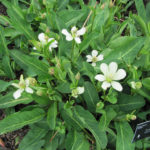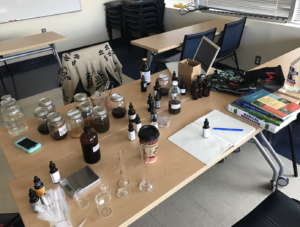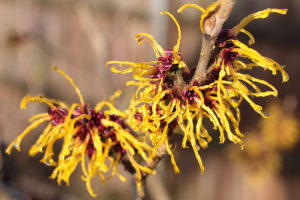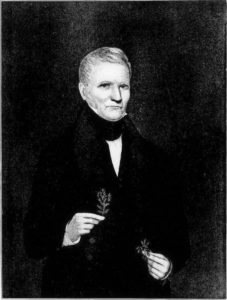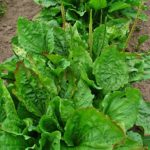Introduction
In the traditional energetic model of western herbal medicine (WHM) one way of conceptualizing energetics is to view them through the lenses of three distinct axes. One lens is energy production which conventionally covers a gradient from cold, cooling, neutral, to warming, hot etc. Another lens is tissue density, which ranges from moistening, through balancing, to drying. A final lens involves tone which comprises concepts such as lax, tense, constricting, relaxing, and nourishing among others (Easley & Horne, 2016; McDonald, 2017).
An intuitive understanding of energetics still exists at the heart of modern allopathic biomedicine where increasingly sophisticated diagnoses are paired with interventions designed to create increasingly sophisticated opposite effects. This awareness of opposites has been grounded in the logic of energetics since the time of Galen of Pergamum. Despite the perceived imprecision that modern reductionist perspectives attribute to energetics, they remain a profound a diagnostic method in most traditional and integrative modalities (East Asian Medical Studies Society, 1985; McDonald, 2017).
Varying traditional energetic models differ somewhat in how they address sour botanicals. In Western herbal medicine (WHM), plant medicines are typically considered cooling, drying, and nourishing (Easley & Horne, 2016). In Traditional Chinese Medicine (TCM) the five element school considers sour botanicals to be moistening and softening whereas the taste/action school views sour plants as primarily astringent and fluid retaining (Kastner, 2009).
Ultimately, this paper proposes that the energetics attributed to sour plants represent a way to understand the pharmacologic actions provided by the constituents of those botanicals. This method of understanding can be applied to acidic and astringent constituents biosynthesized at distinct and increasingly complex layers of the shikimic acid metabolic pathway. Furthermore, the presence of lower pH constituents that trigger sour taste can provide insight into the therapeutic utility of sour plants even if the sour constituents are not the most therapeutically important constituents associated with the plants, as in the case of Schisandra chinensis (Turcz.) Baill.
Molecular perspective on Sour Taste
Our increasingly granular understanding of sour taste transduction (STT) remains imperfect. While a complete picture of the intracellular response involved in sour taste is still hazy, the current consensus is that STT is mediated through potassium ion (k+) channels. Specifically, nonselective cation transient receptor potential channels in the polycystic disease family PKD2L1 (a.k.a. TRPP3) and PKD1L3 (a.k.a TRPP1) (Ishimaru et al., 2006). The genes for these polycystins have been identified in both mouse and human genomes (Li, Tian, Sung, & Somlo, 2003). When the PKD2L1 cells are selectively ablated in animal models, acid induced nerve responses are nearly eliminated (Chandrashekar et al., 2009).
Intracellular acidification also plays a role in the sour taste response. Weak acids can elicit a stronger sour response by diffusing along the lipid bilayer where stronger acids with the same pH are unable to diffuse across the cell membrane. Ye et. al. explored the differing theories for how cytosolic acidification could impact action potentials in sour taste cells and demonstrated that sour taste cells are excited by the direct blocking of resting k+ currents in PKD2L1 cells (Ye et al., 2016).
The presence of the inward-rectifier k+ channel (KIR2.1) in PKD21L cells was identified as initiator of the pH sensitive k+ conductance up to a point. KIR2.1 receptors are also present on non-sour taste receptors cells. The higher density of KIR2.1 on the cell surface of non-sour taste receptors such as TRPM5 creates an insensitivity to intracellular acidification and greatly increases the number of channels that need to be closed to reach the action potential needed for the cell to fire. So it is not just the interaction of intracellular pH on PKD21L, but also the lower magnitude of k+ current that triggers the sour response. Ye et. al. also demonstrate that in the presence of increased intracellular pH, zinc ion (Zn2+) proton conductance is displayed in PKD21L cells but not in TRPM5 cells. This leads to the K+ current being blocked in sour taste cells exclusively (Ye et al., 2016). This coupling of intracellular pH with inhibition of KIR2.1 provides insight into why weak acids are more sour than strong acids at similar ph.
Sour and astringent tastes are frequently conflated and occur simultaneously in a number of sour plants, despite relying on a taste mechanism other than STT, many astringent herbs are frequently classified energetically as cooling and drying with a sour taste such as Camellia sinensis(L.) Kuntze and Hamamelis virginiana L. (Easley & Horne, 2016). From a molecular perspective the sensation of astringency has been shown, unlike sour, to be a combination of the chemosensory and mechanosensory function of the trigeminal (TG) nerve perception of astringent phenols via G Protien-Coupled (GPRC) receptors and mechanical stimulation. This conclusion was corroborated by results of both in-vitro and in-vivo experiments with plant phenols such as epigallocatechin gallate (EGCG) (Schöbel et al., 2014). EGCO comprises as much as 25% of dried C. sinensis (Grigoras & Purdel, 2013).
Biosynthesis of phenolic sour and astringent constituents
Sour and astringent plant phenolics are biosynthesized along many increasingly complex points along the shikimic acid metabolic pathway with some exceptions using the acetate and malonate pathways. This shikimic pathway is not present in Animalia, but many of the acids produced on the shikimate pathway are necessary components in animal metabolism. This need for exogenous essential acids is one narrative for the convergent evolution of sour taste.
Shikimate biosynthesis gives rise to the citric, phenolic and fatty acids. These acids share the presence of a carbonyl group (-CO) and a hydroxyl group (-OH). When these functional groups bond they form a new functional group known collectively as the carboxyl (-COOH) acid group. Carboxyl groups readily esterify with other hydroxyl groups. The lower molecular carboxylic acids are also known as “weak” acids in that they are generally less acidic than the mineral acids. They readily form hydrogen bonds and are therefore highly polar and water soluble. This solubility leads to high bioavailability in water extractions (Ganora, 2009). Many of the astringent tannins are further synthesized by reactions involving gallic acid whereas as higher molecular weight sour phenols are synthesized involving reactions involving cinnamic acid (Kennedy, 2014).
The inclusion of a carboxyl group both in precursor metabolites as well as higher molecular weight phenolic constituents ensures that both low and high molecular weight phenolic compounds are often present in many therapeutic botanicals. The presence of the arguably simpler carboxyl acids makes them prime candidates for being able to initiate STT by inhibiting both KIR2 and k+ ion receptors on PKD2L1 and PKD1L3 cells. Similarly, many botanicals with complex phenolic therapeutic constituents such as hydrolyzable or condensed tannins also contain significant amounts of constituents which will trigger either STT or the sensation of astringency.
Chlorogenic Acids
One group of phenolic acids produced early in the shikimic pathway are the chlorogenic acids (CA). A representative of this group is 3-O-caffeoylquinic acid (3CQA). It is present in many notably sour plants such as Coffee arabicia L., Camellia sinensis(L.) Kuntze, Cratageus spp., and many of the Vaccinium such as V. macrocarpon Aiton and V. corymbosum L. Clinical trials of this constituent lend credence to the traditional energetic claims that sour plants can be cooling and drying and relaxing to tissue.
One controlled clinical trial explored the effects of CA on nitric oxide (NO), endothelial function via flow mediated dilation (FMD) and blood pressure in healthy human subjects. The researchers found a significant reduction in systolic blood pressure (SBP) (−2.41 mmHg, 95% CI: −0.03, −4.78; P = 0.05) as well as diastolic (DBP): (−1.53 mmHg, 95% CI: −0.05, −3.01; P = 0.04). They did not observe a significant change in FMD or NO levels (Mubarak et al., 2012). A more recent clinical trial with a wider range of CAs included did observe a higher FMD (p = 0.151), as well as reductions in SBP (p = 0.684) and DBP (p = 0.835) (Ochiai, Sugiura, Otsuka, Katsuragi, & Hashiguchi, 2015). A third clinical study exploring the effects of CA from green coffee extract found significant reductions in blood pressure (SBP p <0.001, DBP p<0.05) in the intervention group, these researchers propose the possible mechanism may be NO mediated vasodilation (Watanabe et al., 2006).
An inflammatory state with many discrete inputs is implicated in the pathogenesis of liver fibrosis. Hepatic cell lysis leads to an initial cytokine release which triggers Kupffer cells to release even more cytokines. Newly activated hepatic state cells also release cytokines as they produce extracellular matrix in response to injury. Lipopolysaccharides from gram negative bacteria also sensitize liver endothelial cells to produce cytokines. While gold standard human studies of the effect of CA on inflammation are largely absent from the literature, there are a number of promising in-vitro studies. CA was found to decrease the degree of hepatic fibrogenesis in-vitro. It was also found to inhibit the activation of hepatic state cells and decrease the expression of toll-like receptors, nitric oxide synthase and COX-2 and serum levels of tumor necrosis factor, and interleukins 6 and 1B in cell matrixes treated with carbon tetrachloride (Shi et al., 2013). The effects of CA on hepatic ischemia and reperfusion (H-I/R) was also explored by another team of researchers in-vitro. Using an animal model CA was found to significantly attenuate serum alanine aminotransferase levels, portal inflammation, hepatocyte necrosis, hepatic lipid peroxidation and inflammatory cytokine levels at doses of 10 mg/kg (2840.4±688.8 U/L, P<.01). Histologic results produced suggest that CA is a potent inhibitor of the pro-inflammatory protein high mobility group box 1 (HMGB1), TLR, Nuclear Factor Kappa B, and Interferon regulatory factor 1 all of which are significant contributors to the pathophysiology of H-I/R (Yun, Kang, & Lee, 2012).
The cooling, nourishing, and softening effects of CA on human endothelial cells and the promising in-vitro studies pursuant to the liver inflammation argues for the inclusion of botanicals rich in CA when addressing imbalances that give rise to tension and heat in the cardiovascular and hepatic systems.
Epigallocatechin gallate (EGCG)
Oligomeric proanthocyanidins are a class of condensed tannins that form an important group of constituents present in sour botanicals. They are high molecular weight compounds capable of crosslinking with, and ultimately precipitating, proteins. The flavan-3-ol EGCG is a catechin of this class that is present in large amounts in Camellia sinensis(L.) Kuntze a notable astringent botanical (Ganora, 2009). There are an increasing number of human trials exploring the therapeutic effects of EGCG.
One recent study explored the effects of green tea on women with inflammatory lesions associated with acne vulgaris. Patients in the intervention group were given an extract standardized to 856mg of EGCO and assessed after 4 weeks. The researchers found a significant reduction in the number of inflammatory lesions (p = 0.46) leading to a lower score on the Cardiff Acne Disability Index (p = 0.28). The researchers also observed significant reductions in total cholesterol levels within the GTE group (Lu & Hsu, 2016). Another phase II clinical trial explored the efficacy of a topical preparation of EGCG (AverTeaX, Camellix) in reducing the duration and severity of Herpes labialis. The researchers observed a 50% reduction in episode duration in the intervention group (p=.0016). They posit the mechanism is a result of EGCG directly binding to lipid membrane proteins (Zhao et al., 2015). The effect of EGCG on interstitial cystitis has also been explored clinically. A study published in the Journal of Surgical Research explored the effects of EGCG supplementation in-vivo as well as on cultured cell samples from the same test subjects. The intervention group experienced significant reductions in total scores on an analog scale cystitis severity assessment tool. The researchers also explored the effects of EGCG in-vitro on inflammatory markers and observed increased expression of purinergic X receptors and Y receptors in bladder urothelial cells derived from the IC patients. They also recorded reduced expression of inflammatory markers iNOS, phosphorylated Akt, and NF-kB (Liu et al., 2013). EGCG has also been studied as a possible intervention in ulcerative colitis. After 56 days of therapy, 66.7% of the intervention group displayed improved scores on the Mean UC Disease Activity Index (p = 0.03) (Dryden, Lam, Beatty, Qazzaz, & McClain, 2013).
Ultimately, further research is needed. While these studies involved small populations, and comprised results from both human and cellular models, they do contribute to the mounting evidence that phenolic tannins from a plant that is considered sour and astringent can serve therapeutically by providing pharmacological effects that manifest in cooling and drying actions on both internal and external inflammatory imbalances. While not covered in this paper, other clinically important sour botanicals that are high in tannins that are considered cooling and drying include Arctostaphylos uva-ursi (L.) Spreng, Hamamelis virginiana L., Paeonia lactiflora Pall, and Quercus alba L. (Skenderi, 2003).
Schisandrins
Lignans form another class of phenolic compounds comprised of phenlpropanoid derived hydroxycinnamyl alcohols. Some therapeutically important lignans exist exclusively in sour plants, such as Schisandra chinensis (Turcz.) Baill. While considered to encompass all five flavors, S. Chinensis fruit contains a large number of sour phenolics that trigger STT such as malic, tartaric, nigranoic citric, acidargolic and other carboxylic acids. Schisandra also contains the higher molecular weight lignans schisandrin, schisandrins A-C, schizabdrols, schisantherins and gomasin A.
An exhaustive review of S. Cinensis was conducted by Panossian & Wikman in the Journal of Ethnopharmacology. In the review, they outline much of the previous Soviet and post-Soviet era in-vivo research. They summarize evidence that schisandra increases endurance, provides a local anti-inflammatory effect, modulates gastric hypersecretion, as well as reducing the severity of gastric and duodenal ulcers (Panossian & Wikman, 2008). A more recent review discussed results that provide convergent in-vitro evidence that schisandra lignans are also effective vasorelaxants by activating eNOS activity in endothelial cells, as well as exhibition anti-inflammatory characteristics by inhibiting a number of pro-inflammatory cytokines in myocardial tissues (Chun, Cho, So, & Jeon, 2014). Similar in-vitro evidence of the anti-inflammatory effects on the hepatic respiratory and neurological system are covered in another recent review (Szopa, Ekiert, & Ekiert, 2017). Schisandra has also been shown to improve liver function in healthy patients as well as patients with Hepatitis-C (Chiu, Chen, Tzeng, & Wang, 2013; Melhem et al., 2005) Despite its comparatively recent entry into the WHM materia medica schisandra occupies a clinically important niche. From an energetic standpoint, schisandra exhibits cooling and nourishing properties towards inflamed tissue in many disparate organ systems such as the hepatic, cardiovascular and respiratory systems.
Conclusion
Plant energetic classifications are both elegant and messy. Therapeutic plants are complex and traditional energetics represents one of the earlier methods of organizing them in a useful manner. Energetic classifications derive largely from the intimate experience and hard work of practitioners who worked with botanicals in a therapeutic context over the last two millennia. Our increasingly granular understanding of receptor based pharmacology continues to deepen our understanding, and in many cases, these new insights serves to confirm the wisdom of the earlier energetic classifications.
Hopefully, this paper clarifies the link between acidic and astringent plant metabolites of varying molecular weights and the energetic qualities ascribed to them in traditional literature. This paper also serves as an exposition of one method for approaching therapeutic botanicals based on constituent profile. “Working backwards” to energetics from a chemical and pharmacological perspective grounded in the constituent’s biosynthetic pathway. Integrating this modern perspective affords a practitioner the ability to develop a richer understanding of the mechanisms underlying traditional energetics and ultimately inform a more thorough clinical perspective that integrates well with modern biomedicine, to the benefit of the client/patient.
References
Challis, R. C., & Ma, M. (2016). Sour taste finds closure in a potassium channel. Proceedings of the National Academy of Sciences, 113(2), 246–247. https://doi.org/10.1073/pnas.1523319113
Chandrashekar, J., Yarmolinsky, D., Buchholtz, L. von, Oka, Y., Sly, W., Ryba, N. J. P., & Zuker, C. S. (2009). The Taste of Carbonation. Science, 326(5951), 443–445. https://doi.org/10.1126/science.1174601
Chen, X., Huang, Y., Feng, J., Jiang, X.-F., Xiao, W.-F., & Chen, X.-X. (2014). Antioxidant and anti-inflammatory effects of Schisandra and Paeonia extracts in the treatment of asthma. Experimental and Therapeutic Medicine, 8(5), 1479–1483. https://doi.org/10.3892/etm.2014.1948
Chiu, H.-F., Chen, T.-Y., Tzeng, Y.-T., & Wang, C.-K. (2013). Improvement of liver function in humans using a mixture of schisandra fruit extract and sesamin. Phytotherapy Research: PTR, 27(3), 368–373. https://doi.org/10.1002/ptr.4702
Chun, J. N., Cho, M., So, I., & Jeon, J.-H. (2014). The protective effects of Schisandra chinensis fruit extract and its lignans against cardiovascular disease: a review of the molecular mechanisms. Fitoterapia, 97, 224–233. https://doi.org/10.1016/j.fitote.2014.06.014
Da-Costa-Rocha, I., Bonnlaender, B., Sievers, H., Pischel, I., & Heinrich, M. (2014). Hibiscus sabdariffa L. – A phytochemical and pharmacological review. Food Chemistry, 165, 424–443. https://doi.org/10.1016/j.foodchem.2014.05.002
Ding, Y., Cao, Z., Cao, L., Ding, G., Wang, Z., & Xiao, W. (2017). Antiviral activity of chlorogenic acid against influenza A (H1N1/H3N2) virus and its inhibition of neuraminidase. Scientific Reports, 7. https://doi.org/10.1038/srep45723
Dryden, G. W., Lam, A., Beatty, K., Qazzaz, H. H., & McClain, C. J. (2013). A pilot study to evaluate the safety and efficacy of an oral dose of (-)-epigallocatechin-3-gallate-rich polyphenon E in patients with mild to moderate ulcerative colitis. Inflammatory Bowel Diseases, 19(9), 1904–1912. https://doi.org/10.1097/MIB.0b013e31828f5198
Easley, T., & Horne, S. H. (2016). The modern herbal dispensatory: a medicine-making guide. Berkeley, California: North Atlantic Books.
East Asian Medical Studies Society (Ed.). (1985). Fundamentals of Chinese medicine. Brookline, Mass: Paradigm Publications.
Ganora, L. (2009). Herbal constituents: foundations of phytochemistry : a holistic approach for students and practitioners of botanical medicine. Louisville, Colo.: Herbalchem Press.
Grigoras, N., & Purdel, C. (2013, November 12). Assessment report on Camellia sinensis (L.) Kuntze, non fermentatum folium. European Medicines Agency. Retrieved from http://www.ema.europa.eu/docs/en_GB/document_library/Herbal_-_HMPC_assessment_report/2014/04/WC500165886.pdf
Heitman, E., & Ingram, D. K. (2017). Cognitive and neuroprotective effects of chlorogenic acid. Nutritional Neuroscience, 20(1), 32–39. https://doi.org/10.1179/1476830514Y.0000000146
Huyke, C., Engel, K., Simon-Haarhaus, B., Quirin, K.-W., & Schempp, C. M. (2007). Composition and Biological Activity of Different Extracts from Schisandra sphenanthera and Schisandra chinensis. Planta Medica, 73(10), 1116–1126. https://doi.org/10.1055/s-2007-981559
Ishimaru, Y., Inada, H., Kubota, M., Zhuang, H., Tominaga, M., & Matsunami, H. (2006). Transient receptor potential family members PKD1L3 and PKD2L1 form a candidate sour taste receptor. Proceedings of the National Academy of Sciences of the United States of America, 103(33), 12569–12574. https://doi.org/10.1073/pnas.0602702103
Kastner, J. (2009). Chinese nutrition therapy: dietetics in traditional Chinese medicine (TCM) (2nd ed). Stuttgart ; New York: Thieme.
Kennedy, D. O. (2014). Plants and the human brain. New York: Oxford University Press.
Li, A., Tian, X., Sung, S.-W., & Somlo, S. (2003). Identification of two novel polycystic kidney disease-1-like genes in human and mouse genomes. Genomics, 81(6), 596–608.
Liu, M., Xu, Y.-F., Feng, Y., Yang, F.-Q., Luo, J., Zhai, W., … Zheng, J.-H. (2013). Epigallocatechin gallate attenuates interstitial cystitis in human bladder urothelium cells by modulating purinergic receptors. The Journal of Surgical Research, 183(1), 397–404. https://doi.org/10.1016/j.jss.2012.11.041
Lu, P. H., & Hsu, C. H. (2016). Does supplementation with green tea extract improve acne in post-adolescent women? A randomized, double-blind, and placebo-controlled clinical trial. Complementary Therapies in Medicine, 25, 159–163. https://doi.org/10.1016/j.ctim.2016.03.004
McDonald, J. (2017). Foundational Herbcraft – Actions and Energetics in Traditional Western Herbalism.
Melhem, A., Stern, M., Shibolet, O., Israeli, E., Ackerman, Z., Pappo, O., … Ilan, Y. (2005). Treatment of chronic hepatitis C virus infection via antioxidants: results of a phase I clinical trial. Journal of Clinical Gastroenterology, 39(8), 737–742.
Mubarak, A., Bondonno, C. P., Liu, A. H., Considine, M. J., Rich, L., Mas, E., … Hodgson, J. M. (2012). Acute Effects of Chlorogenic Acid on Nitric Oxide Status, Endothelial Function, and Blood Pressure in Healthy Volunteers: A Randomized Trial. Journal of Agricultural and Food Chemistry, 60(36), 9130–9136. https://doi.org/10.1021/jf303440j
Ochiai, R., Sugiura, Y., Otsuka, K., Katsuragi, Y., & Hashiguchi, T. (2015). Coffee bean polyphenols ameliorate postprandial endothelial dysfunction in healthy male adults. International Journal of Food Sciences and Nutrition, 66(3), 350–354. https://doi.org/10.3109/09637486.2015.1007453
Panossian, A., & Wikman, G. (2008). Pharmacology of Schisandra chinensis Bail.: an overview of Russian research and uses in medicine. Journal of Ethnopharmacology, 118(2), 183–212. https://doi.org/10.1016/j.jep.2008.04.020
Santos, M. D. dos, Almeida, M. C., Lopes, N. P., & Souza, G. E. P. de. (2006). Evaluation of the Anti-inflammatory, Analgesic and Antipyretic Activities of the Natural Polyphenol Chlorogenic Acid. Biological and Pharmaceutical Bulletin, 29(11), 2236–2240. https://doi.org/10.1248/bpb.29.2236
Schöbel, N., Radtke, D., Kyereme, J., Wollmann, N., Cichy, A., Obst, K., … Hatt, H. (2014). Astringency Is a Trigeminal Sensation That Involves the Activation of G Protein–Coupled Signaling by Phenolic Compounds. Chemical Senses, 39(6), 1–1.
Shi, H., Dong, L., Jiang, J., Zhao, J., Zhao, G., Dang, X., … Jia, M. (2013). Chlorogenic acid reduces liver inflammation and fibrosis through inhibition of toll-like receptor 4 signaling pathway. Toxicology, 303, 107–114. https://doi.org/10.1016/j.tox.2012.10.025
Sinisi, V., Stevaert, A., Berti, F., Forzato, C., Benedetti, F., Navarini, L., … Vermeire, K. (2017). Chlorogenic Compounds from Coffee Beans Exert Activity against Respiratory Viruses. Planta Medica, 83(7), 615–623. https://doi.org/10.1055/s-0042-119449
Skenderi, G. (2003). Herbal vade mecum: 800 herbs, spices, essential oils, lipids, etc., constituents, properties, uses, and caution. Rutherford, N.J: Herbacy Press.
Szopa, A., Ekiert, R., & Ekiert, H. (2017). Current knowledge of Schisandra chinensis (Turcz.) Baill. (Chinese magnolia vine) as a medicinal plant species: a review on the bioactive components, pharmacological properties, analytical and biotechnological studies. Phytochemistry Reviews, 16(2), 195–218. https://doi.org/10.1007/s11101-016-9470-4
Tajik, N., Tajik, M., Mack, I., & Enck, P. (2017). The potential effects of chlorogenic acid, the main phenolic components in coffee, on health: a comprehensive review of the literature. European Journal of Nutrition. https://doi.org/10.1007/s00394-017-1379-1
Watanabe, T., Arai, Y., Mitsui, Y., Kusaura, T., Okawa, W., Kajihara, Y., & Saito, I. (2006). The Blood Pressure-Lowering Effect and Safety of Chlorogenic Acid from Green Coffee Bean Extract in Essential Hypertension. Clinical and Experimental Hypertension, 28(5), 439–449. https://doi.org/10.1080/10641960600798655
Yang, J., IP, S. P., J. Yeung, H., & Che, C. (2011). HPLC-MS analysis of Schisandra lignans and their metabolites in Caco-2 cell monolayer and rat everted gut sac models and in rat plasma. Acta Pharmaceutica Sinica B, 1(1), 46–55. https://doi.org/10.1016/j.apsb.2011.04.007
Ye, W., Chang, R. B., Bushman, J. D., Tu, Y.-H., Mulhall, E. M., Wilson, C. E., … Liman, E. R. (2016). The K+ channel KIR2.1 functions in tandem with proton influx to mediate sour taste transduction. Proceedings of the National Academy of Sciences, 113(2), E229–E238. https://doi.org/10.1073/pnas.1514282112
Yun, N., Kang, J.-W., & Lee, S.-M. (2012). Protective effects of chlorogenic acid against ischemia/reperfusion injury in rat liver: molecular evidence of its antioxidant and anti-inflammatory properties. The Journal of Nutritional Biochemistry, 23(10), 1249–1255. https://doi.org/10.1016/j.jnutbio.2011.06.018
Zhao, M., Zheng, R., Jiang, J., Dickinson, D., Fu, B., Chu, T.-C., … Hsu, S. (2015). Topical lipophilic epigallocatechin-3-gallate on herpes labialis: a phase II clinical trial of AverTeaX formula. Oral Surgery, Oral Medicine, Oral Pathology and Oral Radiology, 120(6), 717–724. https://doi.org/10.1016/j.oooo.2015.08.018
